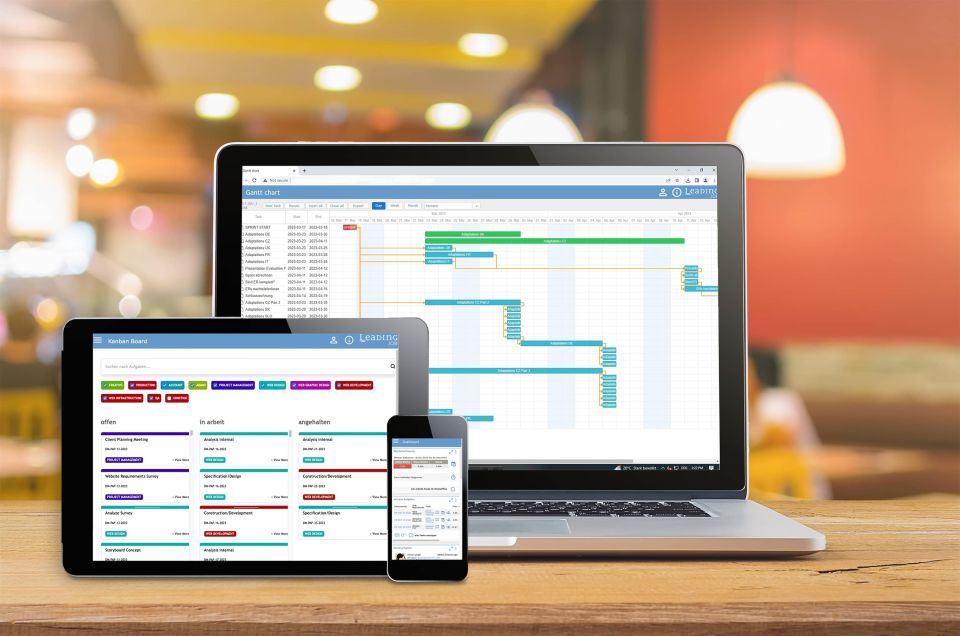Resource Planning 2.0: How to Manage Your Projects Perfectly
So, how is your resource planning going at the moment? Let's assume not so dazzling, otherwise you wouldn't be searching the internet for information about it. Rest assured: It's never too late for good resource planning. And you've come to the right place. We explore the basics of capacity planning, its importance for agencies and how modern software solutions can help manage resources efficiently.
What resource management challenges are typical for advertising agencies and what are industry best practices for optimising capacity planning? Take 5 minutes and read on if you want to make better use of your company's resources in the future than you have in the past.

Table of Contents
What is resource planning and why is it important?
What are the challenges in resource management?
How can agencies optimize their resource planning?
How does software help with resource planning?
How can you measure the efficiency of resource planning?
How do you find the best software for your resource planning?
What Is Resource Planning and Why Is It Important?
Resource planning is the process of allocating and managing required resources such as employees, materials and time in order to carry out projects efficiently and successfully. Both current and future available capacities are taken into account in order to avoid bottlenecks and maximise productivity.
Effective capacity planning is crucial to the success of an agency. Without a clear overview of available resources and their optimal utilisation, projects can stall, leading to delays and increased costs. Careful resource planning ensures that all the necessary resources are available at the right time.
What Are the Challenges in Resource Management?
These situations have probably already played out in your agency in one way or another:
You want to take part in a big pitch for a potential client. But unfortunately, your two best creatives are on holiday at the same time. And now you have to work on the pitch presentation with the back-up team. The chances of securing a new, lucrative contract could be better.
Or you are currently in the decisive phase of an ongoing campaign. Important team members drop out unexpectedly, the salmon from the team's last food order was no longer fresh. Without a backup plan, this leads to delays in realisation and the quality of your otherwise exemplary work is compromised.
Or the production costs for a campaign were underestimated in the cost estimate and now you are left with too many FTEs booked for the campaign, which the client will certainly not be happy about.
Or once again you fail to effectively manage the availability and coordination of internal teams and external freelancers. Peter called Sabine, she replied via Slack, Stefan emailed back and Inge no longer knows who is responsible for the job.
Lack of staff resources, unforeseen absences, budget overruns due to inaccurate cost estimates, inefficient scheduling, lack of communication, these are all signs of poor resource planning and can negatively impact the overall performance of the agency. They show how important it is to implement both strategic planning and flexible contingency solutions to ensure projects run smoothly and achieve agency goals.

How Can Agencies Optimise Their Resource Planning?
Optimising resource planning is an continuous process that requires a range of strategies and tools. Here are some proven methods for improving resource planning:
- Regular review and adjustment: regularly reviewing resource planning helps to identify and eliminate bottlenecks and overcapacity at an early stage. By continuously adapting to current circumstances, planning always remains up-to-date and efficient.
- Use of planning tools and software: Modern planning tools and software solutions offer extensive functions for optimising resource planning. They enable precise allocation of resources and provide real-time data for better decision-making.
- Training and education: Invest in training and upskilling your employees in resource management. Well-trained employees can make resource planning more effective and thus contribute to the successful realisation of projects.
- Communication and collaboration: Open communication and close collaboration within the team and with other departments is crucial for efficient resource planning. Use regular meetings and digital communication tools to encourage dialogue and keep everyone on the same page.
- Proactive planning and scenario analysis: Plan proactively and carry out regular scenario analyses to be prepared for unforeseen events. This helps you to react quickly to changes and adjust resource planning accordingly.
How Does Software Help With Resource Planning?
Modern resource planning software is crucial for agencies to manage their resources efficiently. Agency software offers a wide range of features that greatly simplify and optimise the entire planning process. Firstly, it enables efficient resource management by precisely determining what resources are needed for each project and how best to allocate them. This prevents employees from being overworked or underutilised, which in turn ensures that all projects can be completed on time.
Automated calculations in real time are another great help. This means you always have a clear overview of your current and future available capacities. A transparent visualisation makes it much easier for you to quickly identify free capacities and use them efficiently.
Another particularly important aspect is taking holidays and illness into account. Modern software solutions make it possible to seamlessly integrate foreseeable and unforeseeable absences into resource planning. This allows you to react flexibly and continue your projects as planned despite unexpected events.
In addition, good resource planning software can be easily integrated into your existing work processes. It offers a standardised platform for resource management on which all relevant information can be managed centrally. This improves collaboration within the team and increases efficiency, as everyone involved is always informed about the current status and can act accordingly.
How Can You Measure the Efficiency of Resource Planning?
The efficiency of resource planning can be measured using various key figures and indicators:
- Project time to completion: the time a project takes from start to completion is an important indicator of the efficiency of resource planning. A short project lead time indicates effective planning and resource utilisation.
- Resource utilisation: The utilisation of resources provides information on how efficiently the available capacities are being used. High capacity utilisation while avoiding overload is a sign of good resource planning.
- Cost control: Adherence to the planned budget is an important indicator of the efficiency of resource planning. Projects that are completed within budget show that resources have been utilised effectively and cost-efficiently.
- Employee satisfaction: Employee satisfaction is an important factor for the efficiency of resource planning. Satisfied employees are more motivated and productive, which has a positive impact on project results.
- Adherence to deadlines: Meeting project deadlines is another important indicator. Projects that are completed on time show that resource planning is effective and targeted.

How Do You Find the Best Software for Your Resource Planning?
In today's working world, efficient resource planning is crucial in order to complete projects successfully and on time. Good resource planning software offers all the tools you need for effective resource management. If you are looking for the right software, you should consider the following criteria:
- Functionality: LEADING Job agency software offers comprehensive resource planning functions, including precise capacity planning and simple time tracking. This is because only precise time tracking enables monitoring and up-to-date actual values in the project. In LEADING Job's resource planning, you only enter the number of hours, all other information (which project, which activity, which employee, which hourly rate, which subsequent activity depends on completion in the Gantt chart, which preliminary work must be completed, ...) is already known to the system.
- User-friendliness: LEADING Job is known for its intuitive user interface, which allows users to navigate through the software quickly and efficiently. The clear visualisation of capacities and projects makes day-to-day work much easier.
- Integration: The software can be seamlessly integrated into existing work processes. It offers a standardised platform on which all relevant information can be managed centrally, which significantly improves team collaboration.
- Support and training: LEADING Job offers comprehensive support and training for its users. Qualiant, with over 30 years of industry experience, ensures that clients receive support at all times and can get the most out of their software.
Use LEADING Job to optimise your capacity management and manage your projects efficiently.
Best software for resource planning - Get in touch now
Interested? Try LEADING Job risk-free for up to three months and find out why it's the best software for your agency.

